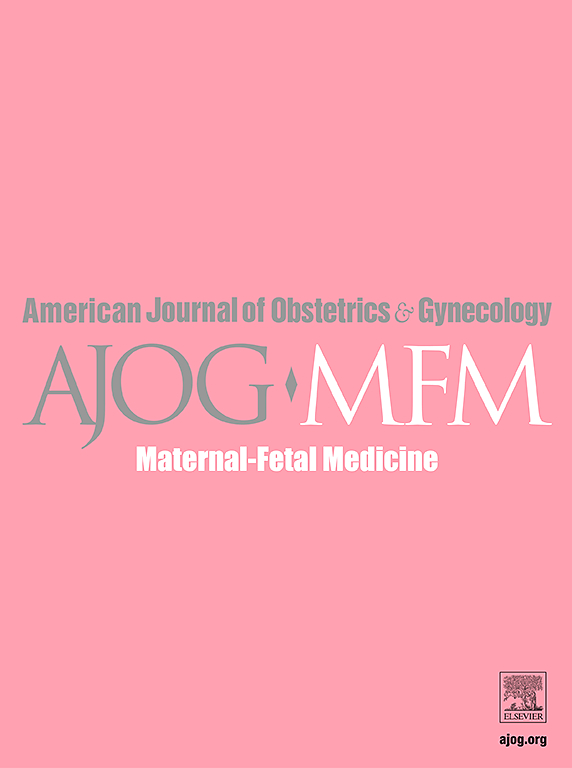Management of twin‐to‐twin transfusion syndrome: update and current challenges
IF 3.1
2区 医学
Q1 OBSTETRICS & GYNECOLOGY
American Journal of Obstetrics & Gynecology Mfm
Pub Date : 2025-06-04
DOI:10.1016/j.ajogmf.2025.101714
引用次数: 0
Abstract
Since a 2004 randomized trial established fetoscopy as the gold standard for the treatment for twin-to-twin transfusion syndrome (TTTS), advancements in surgical technique and expert training have considerably improved survival rates to 89% for at least one fetus and 65% for both fetuses. However, many challenges remain. This review provides an update on the current principles, issues, and debates. The Solomon technique has helped improve neonatal outcomes by reducing the risks of postoperative twin anemia-polycythemia sequence and TTTS recurrence. Nevertheless, fetoscopic laser photocoagulation is associated with significant obstetrical risks, including preterm premature rupture of membranes, preterm delivery, and even placental abruption. Additionally, fetal growth restriction, observed in 30% to 50% of cases, may adversely affect double survival rates following fetoscopy, particularly when abnormal Doppler indices are present. Gestational age (GA) at the time of fetoscopy is a critical prognostic factor, as earlier GA is associated with lower survival rates. This consideration raises questions about the optimal timing of the procedure after TTTS diagnosis. Emerging evidence supports expectant management with close ultrasound monitoring for asymptomatic patients with stage I TTTS. In stage III and IV TTTS, laser photocoagulation should not be delayed, whereas stage II TTTS diagnosed at very early GAs might benefit from expectant management until 16 to 17 weeks of gestation. Further advancements, such as flexible video fetoscopy and computer-assisted fetal laser surgery, represent the next frontier in addressing these challenges.

双胞胎输血综合征的管理:最新和当前的挑战:双胞胎输血综合征的当前挑战。
自从2004年的一项随机试验将胎儿镜检查确立为治疗双胎输血综合征(TTTS)的金标准以来,手术技术和专家培训的进步大大提高了至少一个胎儿的存活率,达到89%,两个胎儿的存活率达到65%。然而,许多挑战依然存在。本综述提供了当前原则、问题和辩论的最新情况。Solomon技术通过降低术后双胞贫血-红细胞增多症序列(TAPS)和TTTS复发的风险,帮助改善了新生儿预后。然而,胎儿镜激光光凝与显著的产科风险相关,包括早产,胎膜早破,早产,甚至胎盘早剥。此外,在30-50%的病例中,胎儿生长受限可能会对胎儿镜检查后的双倍生存率产生不利影响,特别是当多普勒指数出现异常时。胎儿镜检查时的胎龄是一个关键的预后因素,因为较早的胎龄与较低的存活率有关。这一考虑提出了TTTS诊断后最佳手术时机的问题。新出现的证据支持对无症状I期TTTS患者进行密切超声监测的期望管理。在III期和IV期TTTS中,激光光凝治疗不应延迟,而在孕早期诊断的II期TTTS可能受益于妊娠16-17周的预期治疗。进一步的进步,如柔性视频胎儿镜检查和计算机辅助胎儿激光手术,代表了解决这些挑战的下一个前沿。
本文章由计算机程序翻译,如有差异,请以英文原文为准。
求助全文
约1分钟内获得全文
求助全文
来源期刊

American Journal of Obstetrics & Gynecology Mfm
Medicine-Medicine (all)
CiteScore
7.40
自引率
3.20%
发文量
254
审稿时长
40 days
期刊介绍:
The American Journal of Obstetrics and Gynecology (AJOG) is a highly esteemed publication with two companion titles. One of these is the American Journal of Obstetrics and Gynecology Maternal-Fetal Medicine (AJOG MFM), which is dedicated to the latest research in the field of maternal-fetal medicine, specifically concerning high-risk pregnancies. The journal encompasses a wide range of topics, including:
Maternal Complications: It addresses significant studies that have the potential to change clinical practice regarding complications faced by pregnant women.
Fetal Complications: The journal covers prenatal diagnosis, ultrasound, and genetic issues related to the fetus, providing insights into the management and care of fetal health.
Prenatal Care: It discusses the best practices in prenatal care to ensure the health and well-being of both the mother and the unborn child.
Intrapartum Care: It provides guidance on the care provided during the childbirth process, which is critical for the safety of both mother and baby.
Postpartum Issues: The journal also tackles issues that arise after childbirth, focusing on the postpartum period and its implications for maternal health. AJOG MFM serves as a reliable forum for peer-reviewed research, with a preference for randomized trials and meta-analyses. The goal is to equip researchers and clinicians with the most current information and evidence-based strategies to effectively manage high-risk pregnancies and to provide the best possible care for mothers and their unborn children.
 求助内容:
求助内容: 应助结果提醒方式:
应助结果提醒方式:


